
In July of 2021, Google issued a number of warnings for sites publishing medical content that went against its guidelines (for Google News and Discover). The potential for a manual action was clear and some publishers scrambled to figure out what to do.
I mentioned this on Twitter in September:
And six months from the warnings, manual actions arrived for sites that hadn’t cleaned up the problem. Here is my tweet from January when Google issued the manual actions:
To clarify, these were manual actions for Google News and Discover, and not Search. And for the publishers receiving manual actions for medical content, the medical policy for News and Discover states that Google “doesn’t allow publishing medical content that contradicts or runs contrary to scientific or medical consensus and evidence-based best practices.”
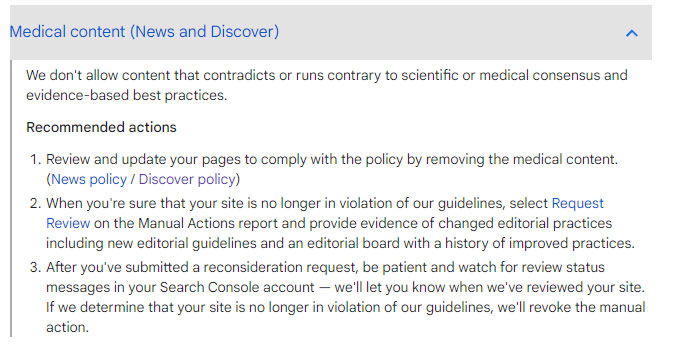
And the manual actions in Google Search Console explained the following:
“Your site appears to violate our medical content policy and contains content primarily aimed at providing medical advice, diagnosis, or treatment for commercial purposes. Nor do we allow content from any site that contradicts or runs contrary to scientific or medical consensus and evidence-based best practices.”
So, if you are publishing medical content, and receive a manual action for violating that policy, News and Discover visibility can be negatively impacted. Again, Search should not be impacted by the manual action, but Google News and Discover visibility could decline.
For example, here is the Discover performance for one of the flagged articles for a publisher that received a manual action:
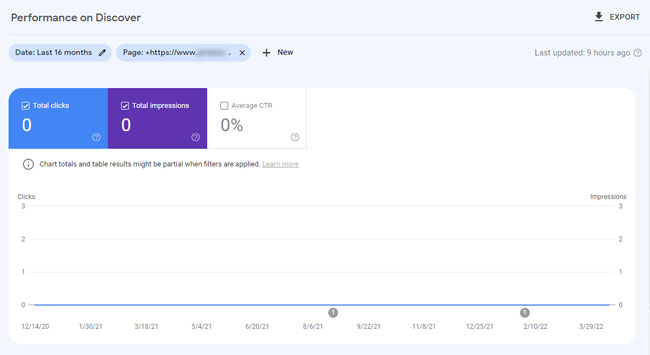
When digging into the articles being flagged by Google, it was super-interesting to see the connection between NewsGuard ratings and the organizations that were covered heavily in the articles. Below, I’ll cover more about NewsGuard and how it could be helpful for sites publishing health and medical content.
Interesting cases and the connection between flagged content and NewsGuard ratings:
In 2018, I wrote a post covering NewsGuard, which I called a proxy for Google’s quality raters. NewsGuard has a team of analysts (trained journalists) that review websites based on nine journalistic criteria, including credibility, transparency, and trust. They originally started by focusing on news organizations, but they have expanded to health and medical as well. For example, there is now a HealthGuard service that, “helps patients, healthcare workers, and anyone involved in the medical field identify trustworthy sources of health information — and avoid dangerous misinformation.”
Once a site is reviewed, NewsGuard produces a “nutritional label” rating the site, which can also appear in the search results if you are using its Chrome plugin. In addition, NewsGuard has relationships with a number of organizations (in several capacities). For example, Bing, Facebook, the American Federation of Teachers (AFT), the World Health Organization (WHO), and others have partnered with NewsGuard to fight disinformation. You can read more about their various partnerships on the site.
Although NewsGuard does have partnerships with several organizations for helping fight misinformation and disinformation, I want to be clear that Google does not use NewsGuard data in its algorithms. But like I explained in my first post, those ratings sometimes line up with how the sites perform in organic search (since Google is also trying to algorithmically surface the highest quality and most authoritative content on the web).
It’s important to understand that Google is on record explaining that its algorithms can be more critical when it comes to health and medical content. Here is a Twitter thread of mine that expands on that point. Again, this is super-important to understand for anyone delving into health and medical content.
For example, here is a health site with a horrible nutritional label from NewsGuard. The site has gotten hammered during broad core updates over time. Again, it’s not because of NewsGuard… it’s just interesting how they line up:
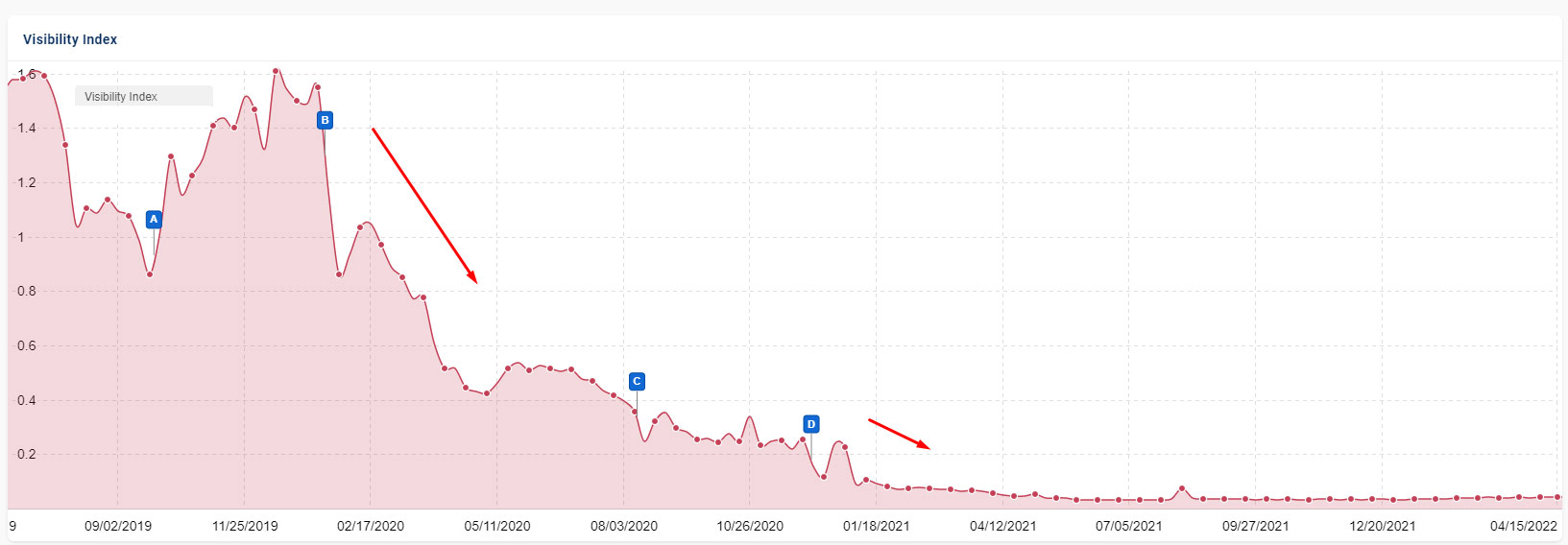
Cross-referencing organizations via NewsGuard based on manual actions for medical content:
For organizations receiving manual actions for medical content (News and Discover), I was interested in cross-referencing NewsGuard to see what the nutritional labels looked like for the organizations being covered (and promoted) in those flagged articles.
And to clarify, it’s not about simply mentioning sketchy organizations that would get content flagged. It’s more about the core of the article being about those organizations (including promoting their views). That’s exactly what the articles were doing that were flagged.
So what did the nutritional labels look like for those organizations being covered? They weren’t good. Not good at all… Here are two examples based on content getting flagged.
Here’s the first site’s label:
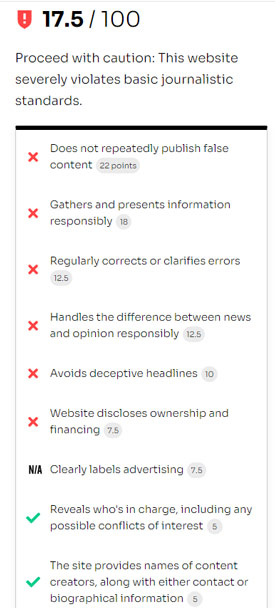
And here’s the second site’s label:
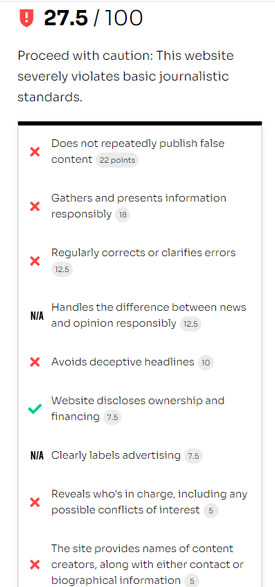
And here is what one of the sites look like in the search results (when you are using the NewsGuard Chrome extension):
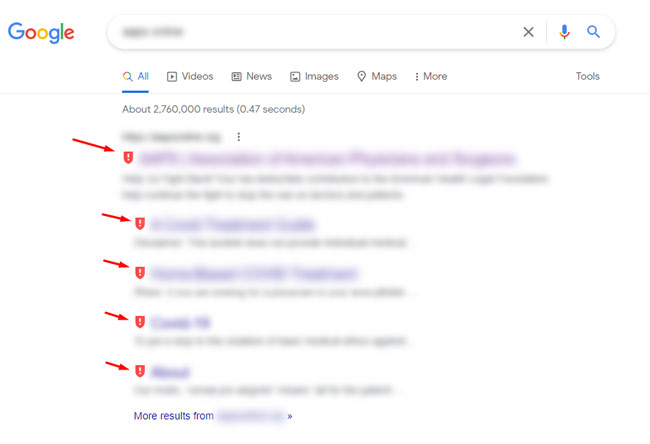
When you hover over the NewsGuard icon (the red shield), you can view an overlay with more details. And that overlay contains a link to the full nutritional label on the NewsGuard website.
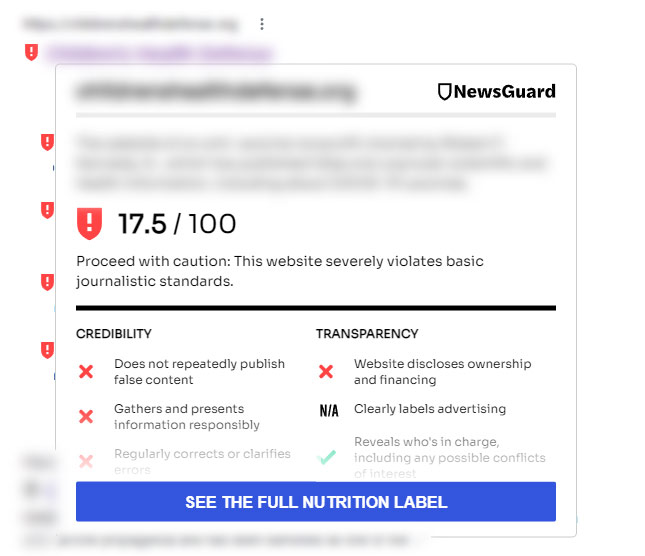
When you visit the nutritional label on NewsGuard’s website, you can find all of the details about why the site received those ratings (and by category). And that includes all of the sources that were cited and referenced in their findings. For example, you can view CNN’s nutritional label here (just to get a feel for what one looks like, review the ratings by category, the sources section at the end, etc.)
Note, the site I mentioned that received the manual action is a large-scale publisher with millions of pages indexed, so most of the content would not fall into this category (covering organizations and views that go against Google’s guidelines). But, they do have some… and they were flagged by Google.
When discussing this situation with the site’s leadership, I explained that having some checks in place would be smart for understanding the risks involved with publishing certain pieces of content. And in my opinion, NewsGuard could be one of those checks.
Utilizing NewsGuard as a check during the publishing process:
So, if you are a site publishing health and medical content, then I would definitely put some checks in place to ensure you don’t receive a manual action for medical content. One solid approach could be adding checks using the NewsGuard plugin (which links to the nutritional labels). If you see red all over the label, you might want to be more cautious (or at least dig in further to learn more about that organization’s views).
For example, if the publisher I’m covering in this post that received the manual action checked NewsGuard before publishing that content, then they probably wouldn’t have published it at all (as long as they understood Google’s policies around medical content for News and Discover). Again, it’s a large-scale publisher with millions of pages indexed. A NewsGuard check could have raised red flags during the editing process.
Note, NewsGuard obviously doesn’t have labels for every site on the web, but understanding the ratings based on the organizations that have been reviewed is a good idea. Again, it was interesting to see the connection between some manual actions for medical content and the sketchy nutritional labels for those organizations being promoted in those articles. Like I explained in my original post about NewsGuard, it’s like a proxy for Google’s quality raters. So in my opinion, it’s smart to check those nutritional labels before publishing.
GG
